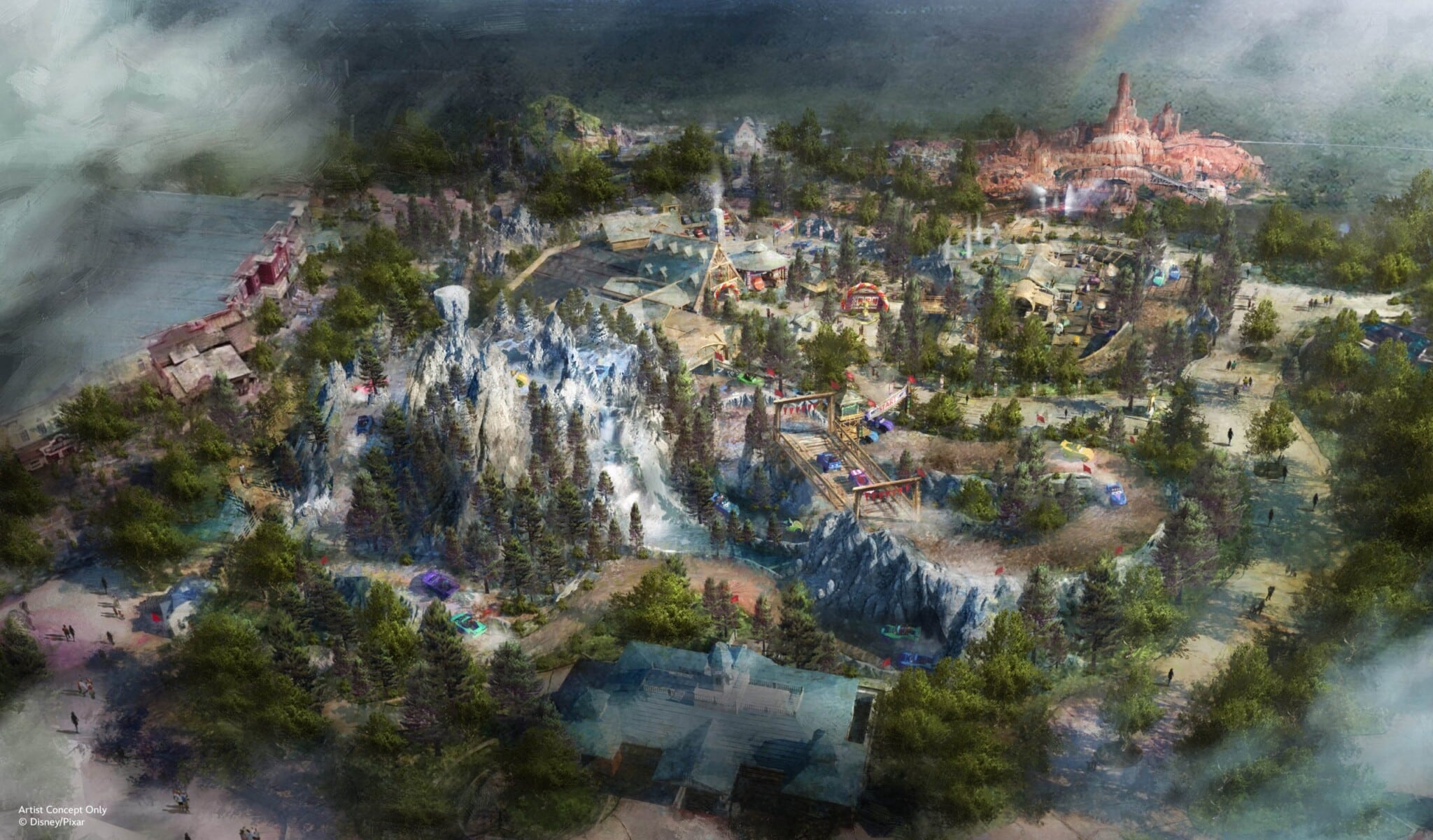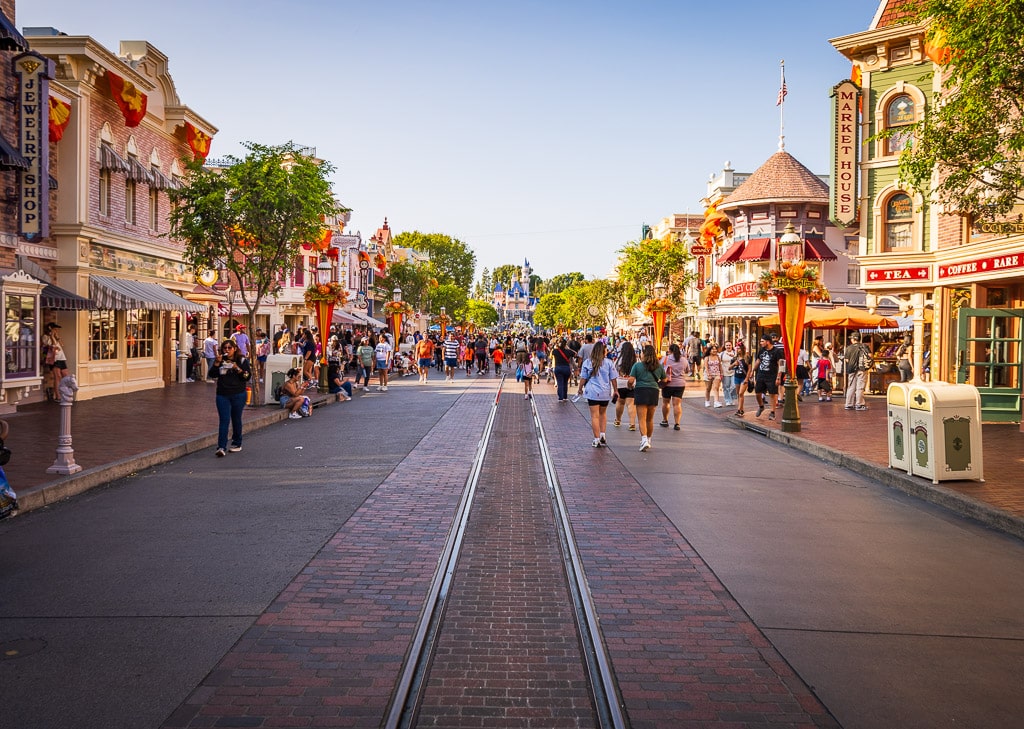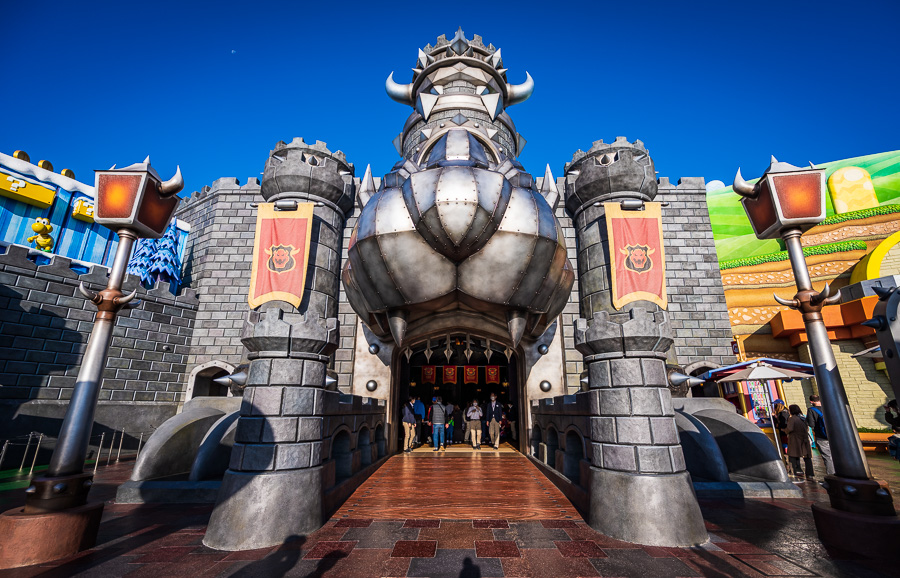
Mario Kart: Bowser’s Challenge is an attraction in Super Nintendo World coming to Universal Studios Hollywood and Epic Universe in Orlando, and now open as Koopa’s Challenge in Japan. This spoiler-free ride review offers our assessment, how it compares to other video game shooters and racers, and other thoughts & commentary.
Universal describes Mario Kart: Bowser’s Challenge as an all-new, technologically-advanced ride that seamlessly fuses cutting-edge augmented reality (AR) with projection mapping technology and actual set pieces along a moving ride track. Set against a multi-sensory backdrop of color, sound and movement, guests are seated in stadium-style, four-seat vehicles as they navigate familiar courses with the integration of head-mounted AR goggles.
The premise of Mario Kart: Bowser’s Challenge is simple but challenging, appealing to guests of all ages regardless of gaming experience, according to Universal. As part of Team Mario, guests steer through a sampling of courses from Mario Kart’s 30-year history to compete for the Golden Cup while collecting coins and defeating enemies to beat Team Bowser.
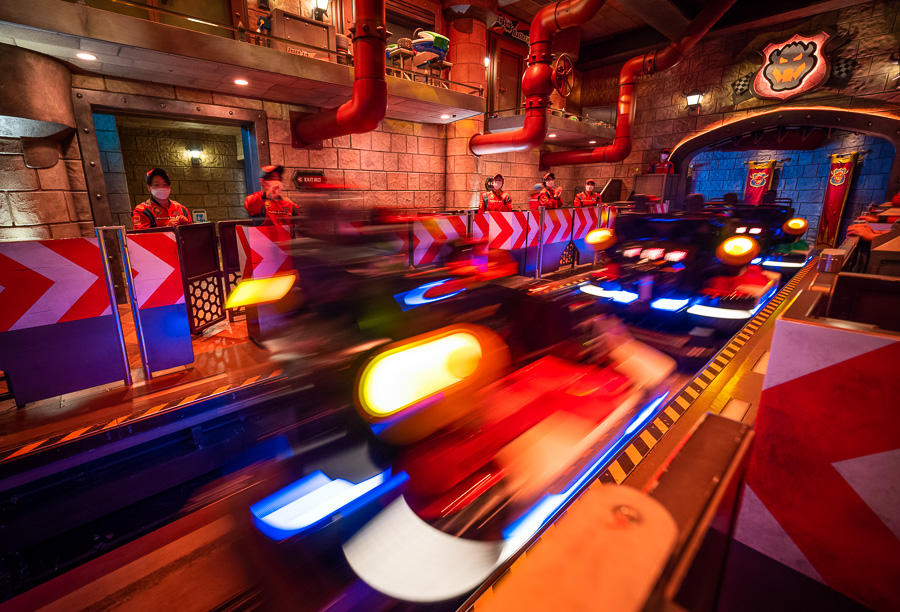
One thing of which I’ve become acutely aware thanks to this site and reader feedback is that the future of theme parks is interactive. Not always in the “gamified” sense of the term, either. Star Wars: Rise of the Resistance is largely successful for the way it puts guests in the center of the action, having an engaging and dynamic quality unlike most passive attractions. Going back even further, the case could be made that Peter Pan’s Flight has enduring popularity for some of the same reasons.
Then there are the interactive rides that are actual games, which have been even more successful. As a general matter, it seems that these rides are graded on a curve by casual guests and overly-harshly by hardcore fans. For our part, we’ve called Toy Story Mania a glorified Wii game and Web Slingers: A Spider-Man Adventure a glorified Xbox Kinect attraction. With these harsh assessments, we also recognize that gamified rides are incredibly popular with guests. For all of our criticism, we also do them a lot.
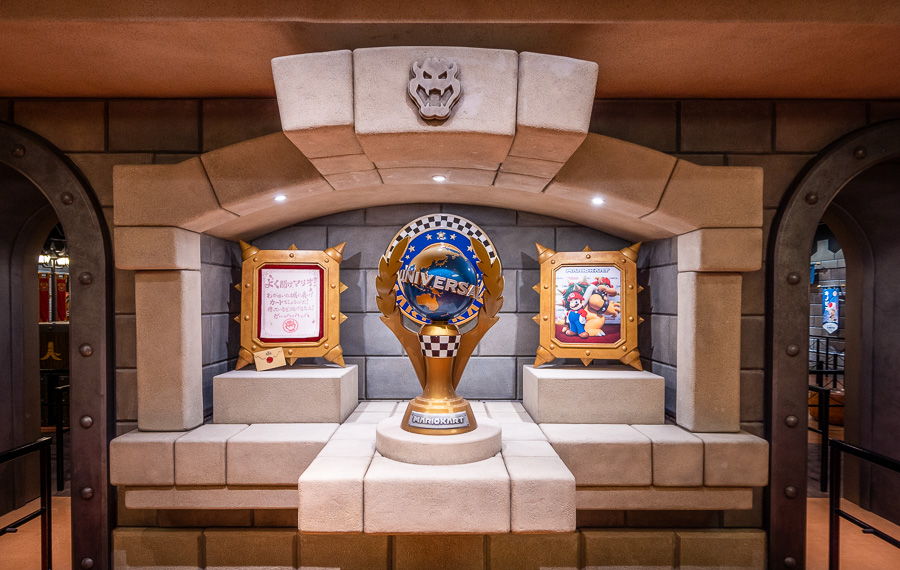
Ironically enough, the Mario Kart ride is not a glorified Nintendo Switch game. Honestly, it’s not really a racer, either. Without question, Mario Kart is Super Nintendo World’s main draw–and a ride that’ll be endlessly scrutinized by theme park and video game fans for not comporting with their exact expectations and preconceived notions.
The stakes are much higher here than with Toy Story game rides. Mario Kart is an actual video game franchise with one of the world’s most recognizable characters by a beloved studio with an ardent fanbase. Against that backdrop, let’s roll into our ride review!
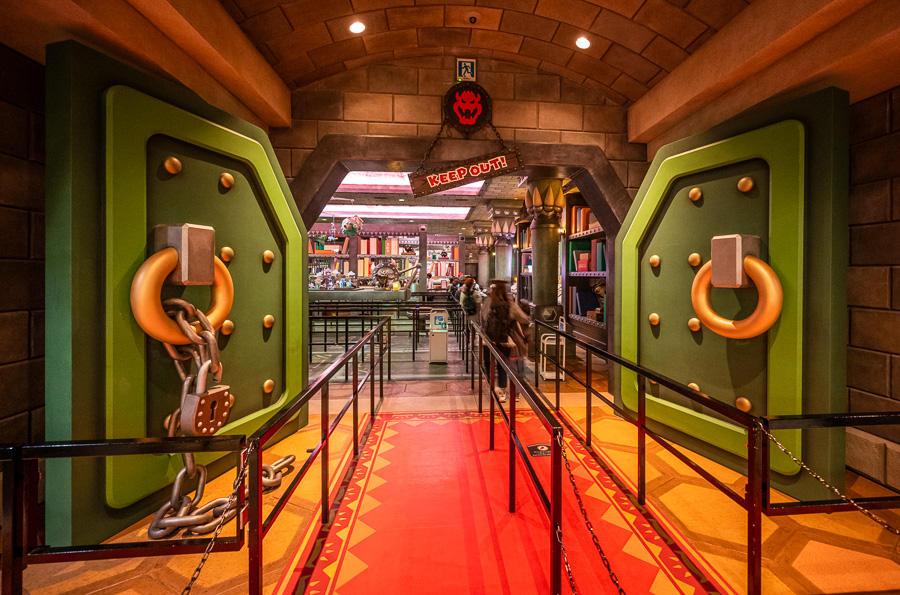
Located inside Bowser’s Castle, the attraction starts setting the scene as soon as you enter its gates. Both the standby and Express Pass queues have plenty to see, with excellent Easter Eggs and nods to the various Mario games over the years. (We also did the Single Rider line, which is much less impressive and should be avoided your first time.)
Being huge tanuki fans, we appreciated seeing Mario’s Tanooki Suit (objectively one of his best suit, although the Cat Suit from Super Mario 3D World gives it a serious run for its money!), among other things. This is a top tier queue, which was absolutely expected after what Universal has done with the Harry Potter rides.
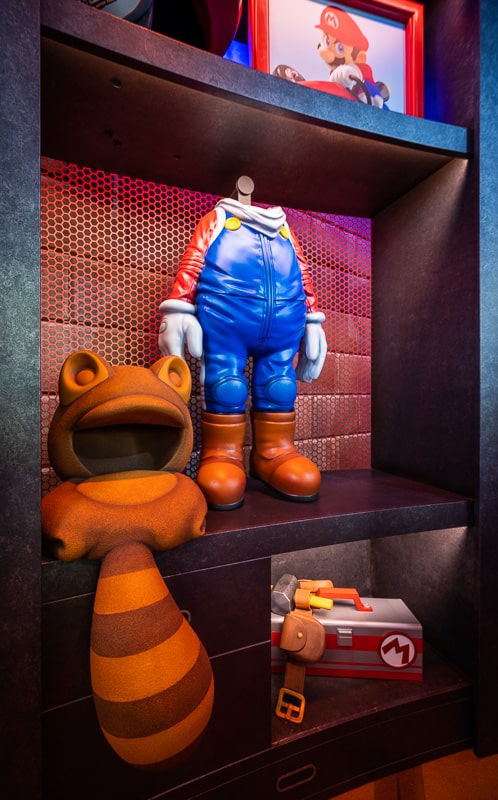
There is so much to see on your tour of Bowser’s Castle that you might just miss some of the instructions explaining how the ride works. If there’s one theme of Super Nintendo World, it’s sensory overload. We very much experienced that with our first time on the Mario Kart ride, and had to learn on the fly as a result.
Towards the end of the queue, you’re given an adjustable plastic Mario visor. You have plenty of time to adjust this so it fits on your head and isn’t uncomfortable–a common complaint we’ve heard about the headset, but not one we experienced ourselves. Once you step into the kart, there’s a special lens that snaps into the visor, which is how you see the AR imagery. You’ll also want to tap-in with your Power-Up Band in order to track your performance, earn coins, and record other achievements.
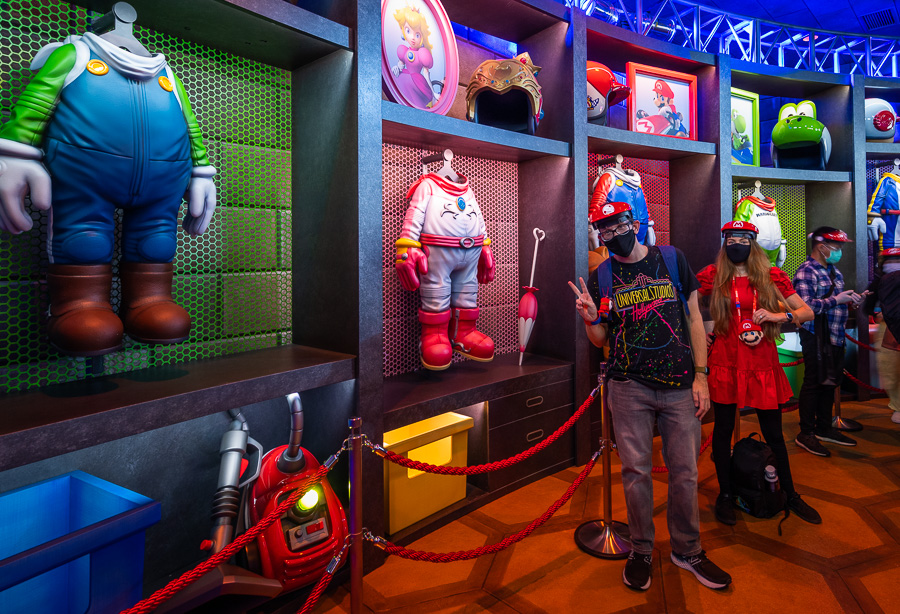
Even if you paid careful attention to the pre-ride instructions, there’s a learning curve that is only overcome by doing. After the kart takes off, there’s a quick practice round where you fire off shells at various enemies flying around you. This is a great opportunity to get your bearings, but it can only do so much.
Once the ride and race actually get going, it can be disorienting with a lot of different things competing for your attention. Do you focus on the augmented reality action and attempt to score as many points as possible? Do you simply enjoy the ride and look at the awesome and engrossing dark ride show scenes? It’s almost impossible to do both simultaneously.
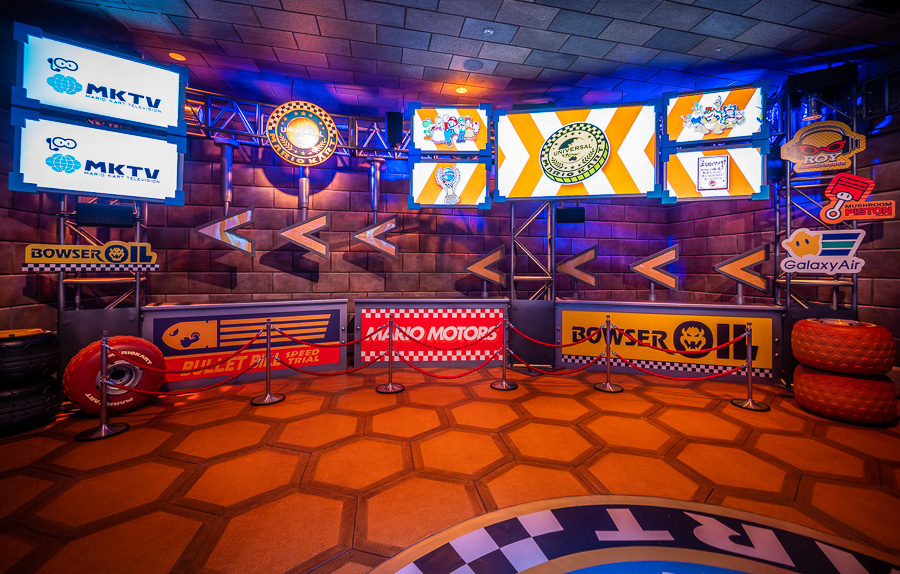
Despite the name and game that inspired it, Mario Kart is only nominally a racing attraction. If you are expecting Radiator Springs Racers: Interactive Mario Edition, you are going to be sorely disappointed. For one, the karts are not fast–this is like Mario Kart played at 5cc. For another, the steering and other aspects of racing are more like quick time events than they are responsive. (Remember, everyone is driving.)
Instead, Mario Kart: Bowser’s Challenge is more like a shooter. The best comparison is probably Buzz Lightyear’s Space Ranger Spin meets Harry Potter and the Forbidden Journey, plus AR. Mario Kart combines the best elements of those two very different attractions, with vibrant and well-done physical sets blended with screens and other tech.
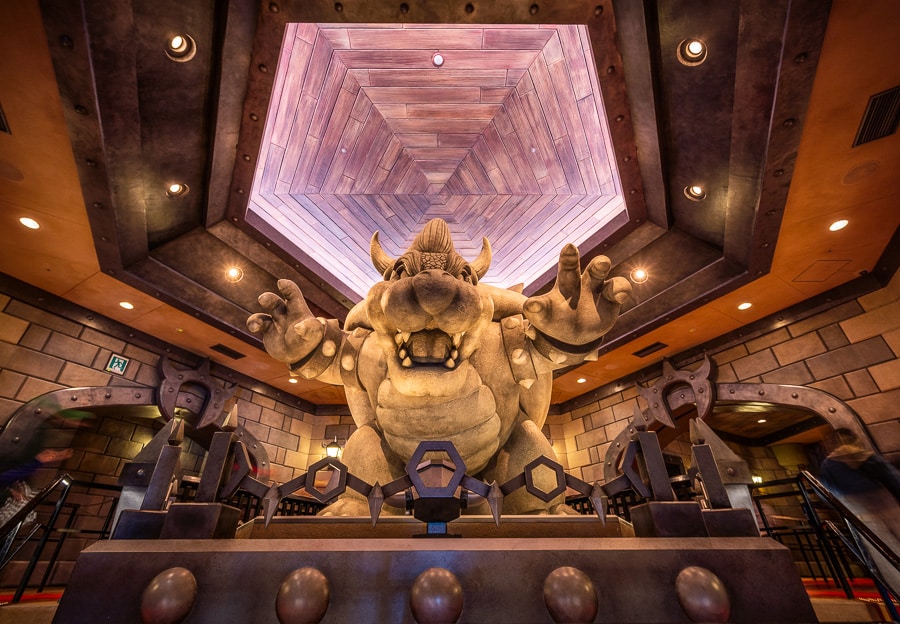
The gamified element focuses primarily on the shooting. Collect shells from item boxes that appear on the course, aim at enemies by turning your head, and then fire with a button attached to the steering wheel. You get coins for successfully hitting enemies, as well as drifting around corners when red arrows pop-up indicating you need to steer left or right–but shooting is the predominant form of gameplay.
Really, the ride is not that different from Mario Kart, except in the balance of shooting v. driving. Players are scored individually, but the whole team needs to contribute to beat Team Bowser. So to that extent, it’s like Web Slingers, the Spider-Man ride in Avengers Campus.
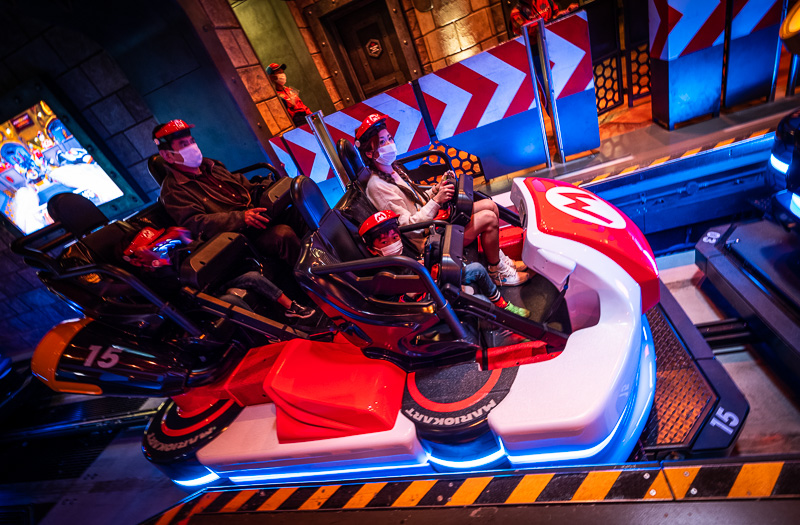
While the ride is slow, there’s simply so much going on in Mario Kart that it’s difficult to fully appreciate it all. Even after multiple re-rides, I still found myself noticing new details about the dark ride or the AR gameplay mechanics. There are portions of the course (looking at you, Rainbow Road!) that are downright intense, and the experience is bound to leave you laughing with or yelling at your crew. Sometimes both.
The whole ride experience is overwhelming and fast-paced, yet immensely satisfying and fun. Mario Kart: Bowser’s Challenge replicates the game that inspired it in the most meaningful way–prompting similar racer reactions and a “let’s do that again!” after finishing a race. I love this ride, warts and all.
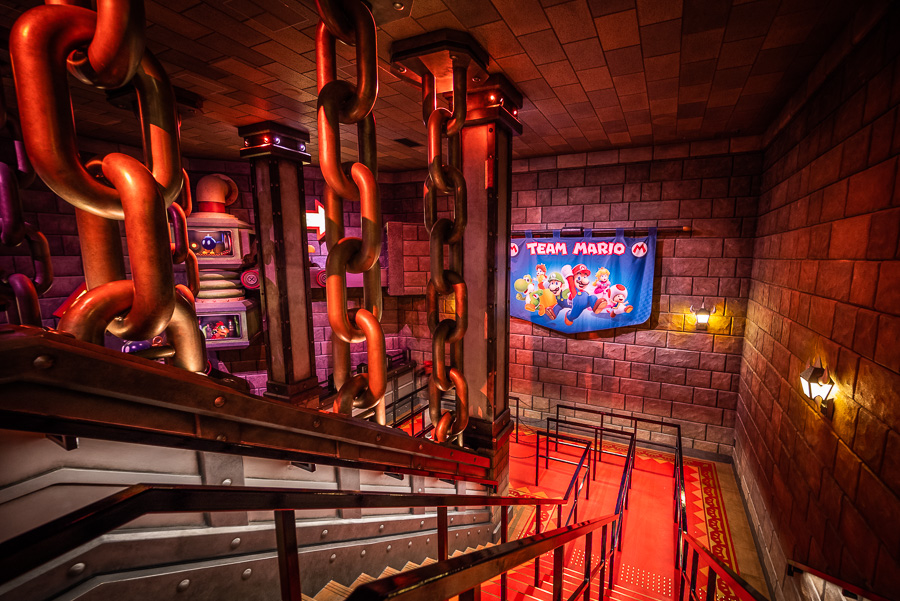
If you’ve only watched ride-throughs on YouTube, this reaction and praise might come as a surprise. It would seem the consensus among “reviewers” who have not experienced the ride is that it’s too slow. And it’s true–this is a slow-moving dark ride on rails. If you’re watching a video, that much is patently obvious–and seemingly at odds with the frenetic energy of Mario Kart. Again, this might disappoint those expecting something speedy like Radiator Springs Racers.
The thing is, if you watch a video of Soarin’ or Avatar Flight of Passage or Star Tours, they are similarly disappointing. The motion is literally simulated in those, and video doesn’t even begin to do them justice. It’s the exact same idea with Mario Kart: Bowser’s Challenge. This is an attraction that hits so much differently when actively playing it in person as opposed to passively watching on a phone screen. Who would’ve thought?!
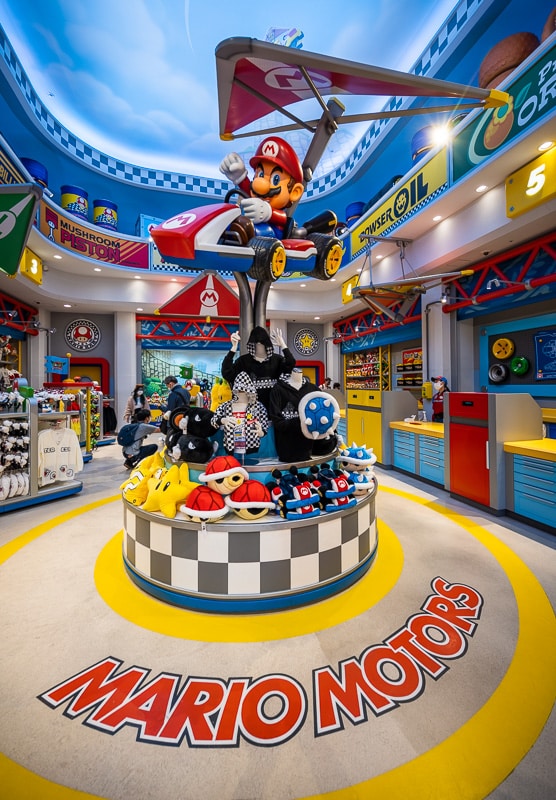
If anything, Mario Kart: Bower’s Challenge is too frantic and chaotic. Adding actual speed to the course would’ve made the wheels fall off, figuratively speaking. The interactivity wouldn’t have worked and the ride would’ve been too disorienting for the vast majority of guests.
I would argue that the choice to go slow was the right one, and the result is one that captures the spirit of Mario Kart’s frenzied racing perfectly, even at a slow speed. To that point, I think the ride has just the right amount of chaos and the pacing is pitch-perfect. Universal Creative had an unenviable task in attempting to balance all of the competing elements that define playing Mario Kart. For me, what matters less is each individual element and the overall feeling of the experience. From my perspective, they nailed the vibe.
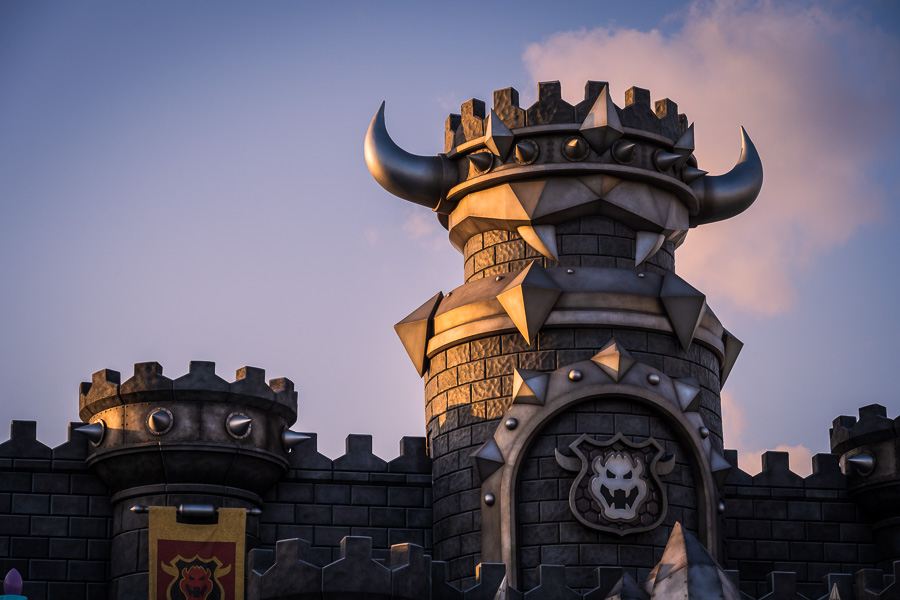
One thing that’s worth addressing is the learning curve, which is always going to exist in gamified attractions. It’s exceedingly difficult to make an attraction accessible to non-gamers while still being sufficiently appealing to hardcore gamers. Our party ran the video gaming gamut, from novice to expert.
At the beginner end of the spectrum, there was definitely difficulty figuring things out. The first ride was essentially a practice and learning run, for all intents and purposes, as a result. At the other end of the spectrum, there was a degree of disappointment at the simplicity of the play. As the rider in the middle of that spectrum, I felt the experience was almost perfectly balanced–approachable enough for non-gamers while sufficiently challenging and addictive enough for actual gamers.
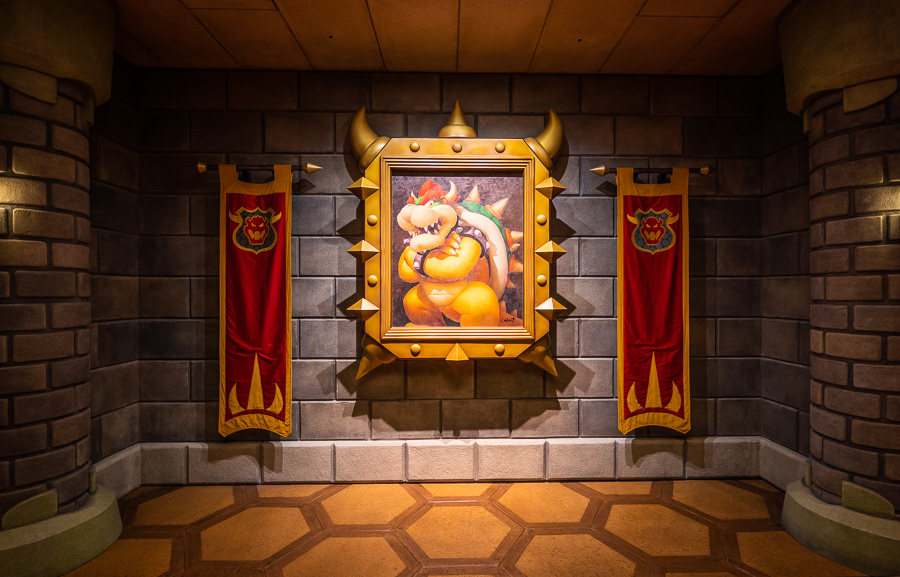
Nevertheless, I’ll also concede that gamified attractions are among the most polarizing with hardcore theme park fans (and presumably with gamers). Some click and some fall flat, and “success” can vary from fan-to-fan. Mario Kart: Bowser’s Challenge attempts to be both a slow-moving dark ride and gamified attraction–rather than just the latter, like Toy Story Mania.
I think this is the greatest asset of Mario Kart: Bowser’s Challenge, but that also means striking the right balance can be tricky. Some might contend that trying to be everything to everyone makes it mediocre for all. I vehemently disagree, finding the compromises of Mario Kart to bring better balance and crowd-pleasing qualities to the attraction. Thanks to that, it cannot be fairly accused of being too screen or thrill-dependent, as is commonly the case for Universal rides. This is a family-friendly attraction, through and through.
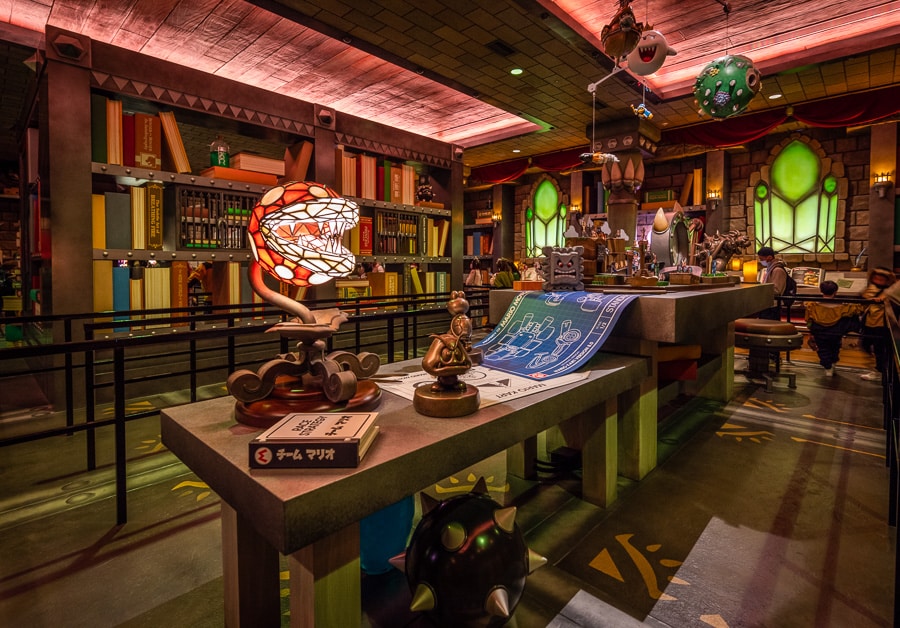
Another thing I’ll concede is that this is quite clearly an early generation AR ride. Without question, the technology is going to continue to evolve, and what’s possible in a few years will likely lap Mario Kart: Bowser’s Challenge. You could argue that this ride is both ahead of its time and perhaps being released prematurely, before the tech is ready for primetime.
Universal has a pretty good track record with updating its tech-heavy attractions, so hopefully there are plans to do the same with Mario Kart. I cannot imagine that the USJ version will be exactly what opens at Epic Universe some 5 years later. If it is, that will be a massive fail.
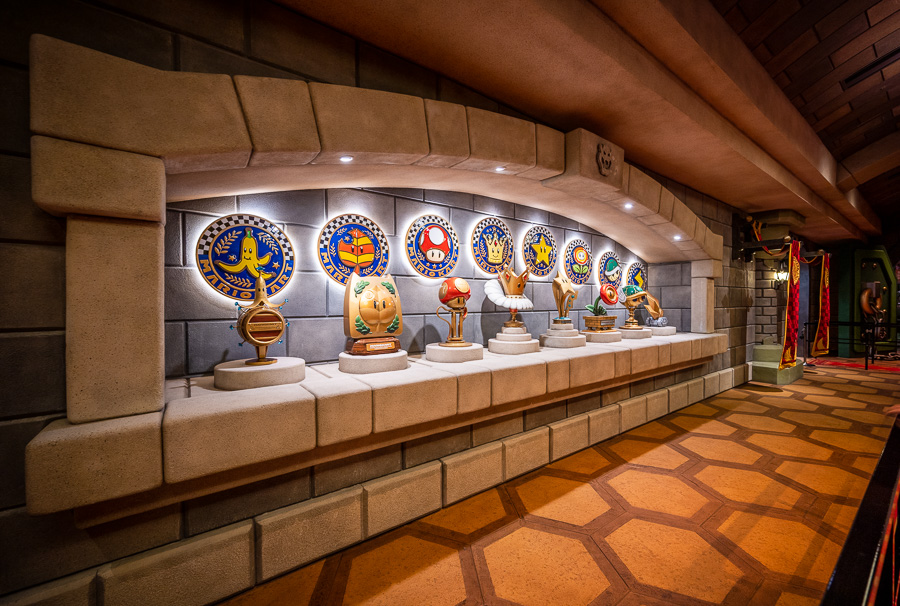
From my perspective, the AR never gets in its own way on Mario Kart: Bowser’s Challenge. With that said, the visuals can become slightly choppy or vanish from view when you move your head too quickly or eyes outside the field of view.
Due to the current limitations of AR, riders need to adjust for this; I found that seldom happens once you get your bearings on how the AR works and know where to look and how to move your head around. After completing the practice round, it became pretty intuitive for me.

My other quibble with the way Mario Kart: Bowser’s Challenge “stacks” AR on top of screens and physical sets is that it’s not always seamless. On occasion, I found myself looking at the AR–not through it–and missing the scenery that’s supposed to blend together.
This can make suspension of disbelief difficult, and there are definitely times when I made a concerted effort to separate out the AR from the scenery so I could enjoy the latter. This isn’t always an issue–there are some segments that are incredibly engrossing and fully immersive. (It’s also one of those things that’s highly subjective–it may all blend together for you, or none of it might.)
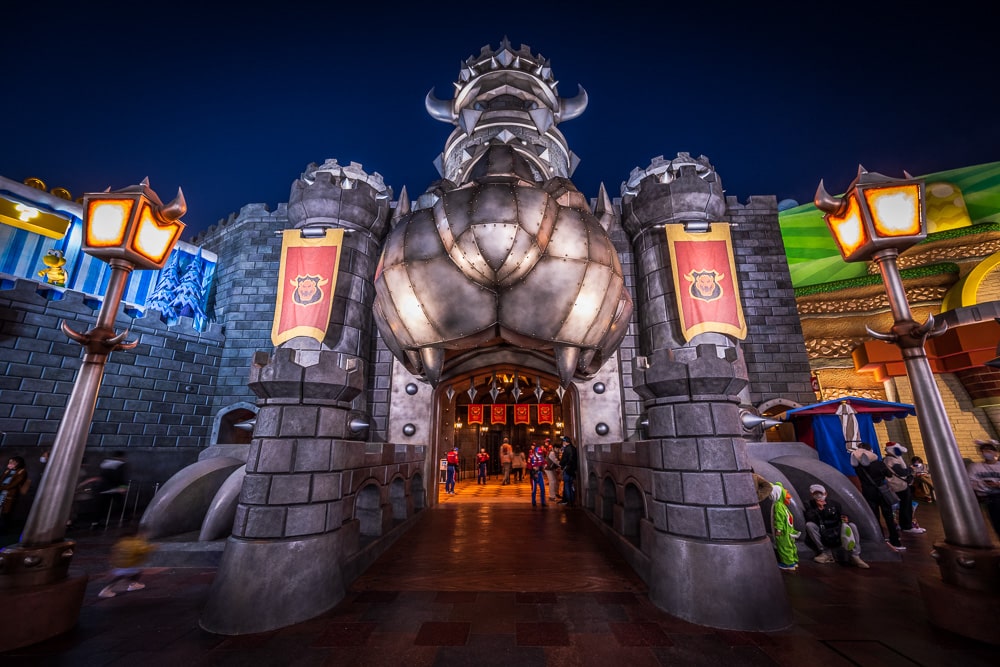
Ultimately, Mario Kart: Bowser’s Challenge is one of the most envelope-pushing and ambitious attractions I’ve ever experienced in any theme park. Like the best Mario Kart courses, it’s the perfect mixture of frustrating, fun, and addictive. You want to keep coming back, seeing what you missed before, and improving your results.
It’s almost nothing like other gamified attractions, eschewing simple and static screens for a hybrid approach that melds dimensional dark ride scenes with engrossing screens along with augmented reality. The way it integrates all of this is truly impressive–but also important. If the interactive element of Mario Kart: Bowser’s Challenge doesn’t quite “click” for you, the attraction is still enjoyable as a traditional dark ride.
There’s a decent chance that’ll be the case for many riders, as the disparate elements of Mario Kart don’t always fire on all cylinders to create a sense of complete immersion or suspension of disbelief. However, when the ride experience coalesces or riders get into their gaming groove, it’s unrivaled. When Mario Kart hits those high notes on Rainbow Road, it becomes a seamless blend of video game and dark ride unlike anything else. Mario Kart: Bowser’s Challenge may misfire for some, but it also revolutionizes and is an early look at the future of interactive dark rides. In fitting fashion, Mario once again changes the game–but unlike Super Mario 64, this gamechanger doesn’t fully realize its potential, and instead paves the way for subsequent iterations of Mario Kart or other interactive attractions.
If you’re preparing for a Southern California vacation, check out our other planning posts, including our exhaustive Guide to Universal Studios Hollywood. Need advice for LA? Read our Ultimate Los Angeles, California Planning Guide. Visiting other SoCal theme parks? Consult our comprehensive Disneyland Vacation Planning Guide and Knott’s Berry Farm Planning Guide.
YOUR THOUGHTS
Have you experienced Mario Kart: Koopa’s Challenge? Looking forward to playing Bowser’s Challenge at Universal Studios Hollywood or Epic Universe? What did you think of this attraction? Wish it were faster, or pleased with the balance of interactive shooting and racing? Do you agree or disagree with our assessment? Any questions? Would you like to see a review of the entire land? What about a Super Nintendo World strategy & planning post? Hearing your feedback–even when you disagree with us–is both interesting to us and helpful to other readers, so please share your thoughts below in the comments!




